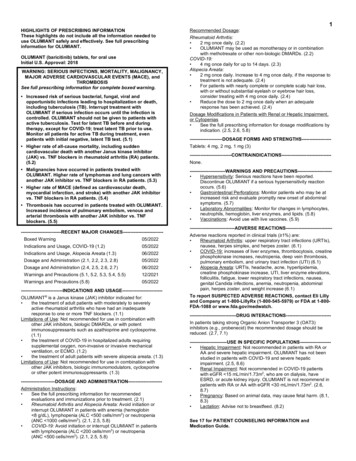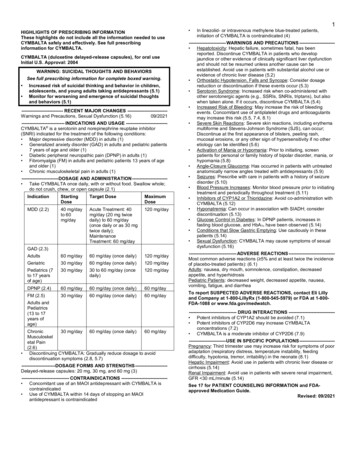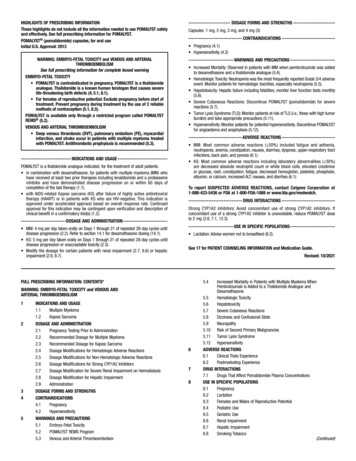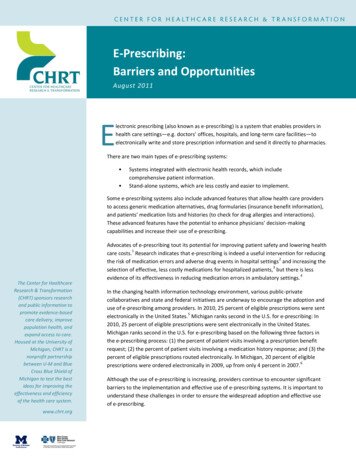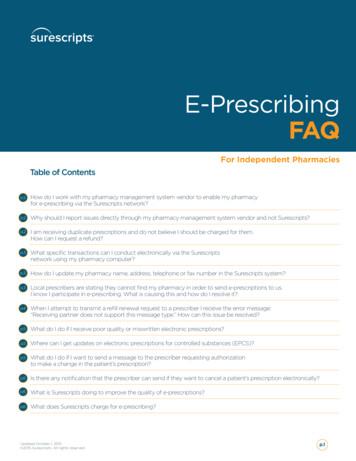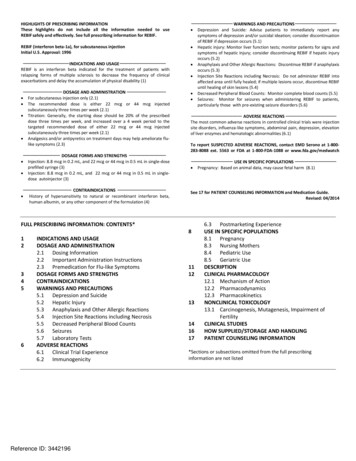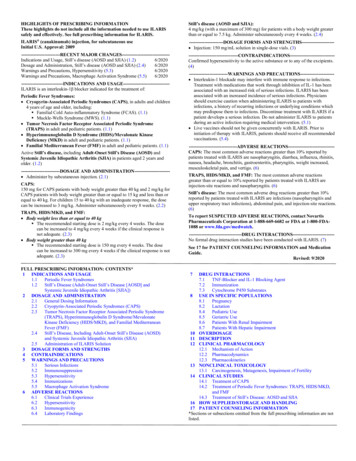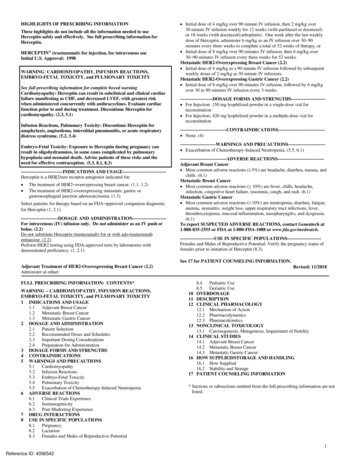
Transcription
HIGHLIGHTS OF PRESCRIBING INFORMATIONThese highlights do not include all the information needed to useHerceptin safely and effectively. See full prescribing information forHerceptin.HERCEPTIN (trastuzumab) for injection, for intravenous useInitial U.S. Approval: 1998WARNING: CARDIOMYOPATHY, INFUSION REACTIONS,EMBRYO-FETAL TOXICITY, and PULMONARY TOXICITYSee full prescribing information for complete boxed warningCardiomyopathy: Herceptin can result in subclinical and clinical cardiacfailure manifesting as CHF, and decreased LVEF, with greatest riskwhen administered concurrently with anthracyclines. Evaluate cardiacfunction prior to and during treatment. Discontinue Herceptin forcardiomyopathy. (2.3, 5.1)Infusion Reactions, Pulmonary Toxicity: Discontinue Herceptin foranaphylaxis, angioedema, interstitial pneumonitis, or acute respiratorydistress syndrome. (5.2, 5.4)Embryo-Fetal Toxicity: Exposure to Herceptin during pregnancy canresult in oligohydramnios, in some cases complicated by pulmonaryhypoplasia and neonatal death. Advise patients of these risks and theneed for effective contraception. (5.3, 8.1, 8.3)---------------------------INDICATIONS AND USAGE---------------------------Herceptin is a HER2/neu receptor antagonist indicated for: The treatment of HER2-overexpressing breast cancer. (1.1, 1.2)The treatment of HER2-overexpressing metastatic gastric orgastroesophageal junction adenocarcinoma. (1.3)Select patients for therapy based on an FDA-approved companion diagnosticfor Herceptin (1, 2.1).------------------------DOSAGE AND ADMINISTRATION--------------------- For intravenous (IV) infusion only. Do not administer as an IV push orbolus. (2.2)Do not substitute Herceptin (trastuzumab) for or with ado-trastuzumabemtansine. (2.2)Perform HER2 testing using FDA-approved tests by laboratories withdemonstrated proficiency. (1, 2.1) Initial dose of 4 mg/kg over 90 minute IV infusion, then 2 mg/kg over30 minute IV infusion weekly for 12 weeks (with paclitaxel or docetaxel)or 18 weeks (with docetaxel/carboplatin). One week after the last weeklydose of Herceptin, administer 6 mg/kg as an IV infusion over 30 90minutes every three weeks to complete a total of 52 weeks of therapy, or Initial dose of 8 mg/kg over 90 minutes IV infusion, then 6 mg/kg over30 90 minutes IV infusion every three weeks for 52 weeks.Metastatic HER2-Overexpressing Breast Cancer (2.2) Initial dose of 4 mg/kg as a 90 minute IV infusion followed by subsequentweekly doses of 2 mg/kg as 30 minute IV infusions.Metastatic HER2-Overexpressing Gastric Cancer (2.2) Initial dose of 8 mg/kg over 90 minutes IV infusion, followed by 6 mg/kgover 30 to 90 minutes IV infusion every 3 weeks.---------------------DOSAGE FORMS AND STRENGTHS--------------------- For Injection: 150 mg lyophilized powder in a single-dose vial forreconstitution For Injection: 420 mg lyophilized powder in a multiple-dose vial TRAINDICATIONS----------------------------- None. (4)-----------------------WARNINGS AND PRECAUTIONS----------------------- Exacerbation of Chemotherapy-Induced Neutropenia. (5.5, 6.1)------------------------------ADVERSE REACTIONS-----------------------------Adjuvant Breast Cancer Most common adverse reactions ( 5%) are headache, diarrhea, nausea, andchills. (6.1)Metastatic Breast Cancer Most common adverse reactions ( 10%) are fever, chills, headache,infection, congestive heart failure, insomnia, cough, and rash. (6.1)Metastatic Gastric Cancer Most common adverse reactions ( 10%) are neutropenia, diarrhea, fatigue,anemia, stomatitis, weight loss, upper respiratory tract infections, fever,thrombocytopenia, mucosal inflammation, nasopharyngitis, and dysgeusia.(6.1)To report SUSPECTED ADVERSE REACTIONS, contact Genentech at1-888-835-2555 or FDA at 1-800-FDA-1088 or www.fda.gov/medwatch.----------------------USE IN SPECIFIC POPULATIONS--------------------- Females and Males of Reproductive Potential: Verify the pregnancy status offemales prior to initiation of Herceptin (8.3).See 17 for PATIENT COUNSELING INFORMATION.Adjuvant Treatment of HER2-Overexpressing Breast Cancer (2.2)Administer at either:Revised: 11/2018FULL PRESCRIBING INFORMATION: CONTENTS*WARNING CARDIOMYOPATHY, INFUSION REACTIONS,EMBRYO-FETAL TOXICITY, and PULMONARY TOXICITY1 INDICATIONS AND USAGE1.1Adjuvant Breast Cancer1.2Metastatic Breast Cancer1.3Metastatic Gastric Cancer2 DOSAGE AND ADMINISTRATION2.1Patient Selection2.2Recommended Doses and Schedules2.3Important Dosing Considerations2.4Preparation for Administration3 DOSAGE FORMS AND STRENGTHS4 CONTRAINDICATIONS5 WARNINGS AND PRECAUTIONS5.1Cardiomyopathy5.2Infusion Reactions5.3Embryo-Fetal Toxicity5.4Pulmonary Toxicity5.5Exacerbation of Chemotherapy-Induced Neutropenia6 ADVERSE REACTIONS6.1Clinical Trials Experience6.2Immunogenicity6.3Post-Marketing Experience7 DRUG INTERACTIONS8 USE IN SPECIFIC POPULATIONS8.1Pregnancy8.2Lactation8.3Females and Males of Reproductive Potential101112131416178.4Pediatric Use8.5Geriatric UseOVERDOSAGEDESCRIPTIONCLINICAL PHARMACOLOGY12.1 Mechanism of Action12.2 Pharmacodynamics12.3 PharmacokineticsNONCLINICAL TOXICOLOGY13.1 Carcinogenesis, Mutagenesis, Impairment of FertilityCLINICAL STUDIES14.1 Adjuvant Breast Cancer14.2 Metastatic Breast Cancer14.3 Metastatic Gastric CancerHOW SUPPLIED/STORAGE AND HANDLING16.1 How Supplied16.2 Stability and StoragePATIENT COUNSELING INFORMATION* Sections or subsections omitted from the full prescribing information are notlisted.1Reference ID: 4356542
FULL PRESCRIBING INFORMATIONWARNING: CARDIOMYOPATHY, INFUSION REACTIONS, EMBRYO-FETALTOXICITY, and PULMONARY TOXICITYCardiomyopathyHerceptin administration can result in sub-clinical and clinical cardiac failure. Theincidence and severity was highest in patients receiving Herceptin withanthracycline-containing chemotherapy regimens.Evaluate left ventricular function in all patients prior to and during treatment withHerceptin. Discontinue Herceptin treatment in patients receiving adjuvant therapy andwithhold Herceptin in patients with metastatic disease for clinically significant decrease in leftventricular function [see Dosage and Administration (2.3) and Warnings and Precautions (5.1)].Infusion Reactions; Pulmonary ToxicityHerceptin administration can result in serious and fatal infusion reactions and pulmonarytoxicity. Symptoms usually occur during or within 24 hours of Herceptin administration.Interrupt Herceptin infusion for dyspnea or clinically significant hypotension. Monitorpatients until symptoms completely resolve. Discontinue Herceptin for anaphylaxis,angioedema, interstitial pneumonitis, or acute respiratory distress syndrome [see Warningsand Precautions (5.2, 5.4)].Embryo-Fetal ToxicityExposure to Herceptin during pregnancy can result in oligohydramnios andoligohydramnios sequence manifesting as pulmonary hypoplasia, skeletal abnormalities, andneonatal death. Advise patients of these risks and the need for effective contraception [seeWarnings and Precautions (5.3) and Use in Specific Populations (8.1, 8.3)].1INDICATIONS AND USAGE1.1 Adjuvant Breast CancerHerceptin is indicated for adjuvant treatment of HER2 overexpressing node positive or nodenegative (ER/PR negative or with one high risk feature [see Clinical Studies (14.1)]) breast cancer as part of a treatment regimen consisting of doxorubicin, cyclophosphamide, and eitherpaclitaxel or docetaxel as part of a treatment regimen with docetaxel and carboplatin as a single agent following multi-modality anthracycline based therapy.Select patients for therapy based on an FDA-approved companion diagnostic for Herceptin [seeDosage and Administration (2.1)].1.2 Metastatic Breast CancerHerceptin is indicated: In combination with paclitaxel for first-line treatment of HER2-overexpressing metastaticbreast cancer As a single agent for treatment of HER2-overexpressing breast cancer in patients who havereceived one or more chemotherapy regimens for metastatic disease.Select patients for therapy based on an FDA-approved companion diagnostic for Herceptin [seeDosage and Administration (2.1)].1.3 Metastatic Gastric CancerHerceptin is indicated, in combination with cisplatin and capecitabine or 5-fluorouracil, for thetreatment of patients with HER2-overexpressing metastatic gastric or gastroesophageal junctionadenocarcinoma who have not received prior treatment for metastatic disease.2Reference ID: 4356542
Select patients for therapy based on an FDA-approved companion diagnostic for Herceptin [seeDosage and Administration (2.1)].2DOSAGE AND ADMINISTRATION2.1 Patient SelectionSelect patients based on HER2 protein overexpression or HER2 gene amplification in tumorspecimens [see Indications and Usage (1) and Clinical Studies (14)]. Assessment of HER2 proteinoverexpression and HER2 gene amplification should be performed using FDA-approved testsspecific for breast or gastric cancers by laboratories with demonstrated proficiency. Information onthe FDA-approved tests for the detection of HER2 protein overexpression and HER2 geneamplification is available at: http://www.fda.gov/CompanionDiagnostics.Assessment of HER2 protein overexpression and HER2 gene amplification in metastatic gastriccancer should be performed using FDA-approved tests specifically for gastric cancers due todifferences in gastric vs. breast histopathology, including incomplete membrane staining and morefrequent heterogeneous expression of HER2 seen in gastric cancers.Improper assay performance, including use of suboptimally fixed tissue, failure to utilizespecified reagents, deviation from specific assay instructions, and failure to include appropriatecontrols for assay validation, can lead to unreliable results.2.2 Recommended Doses and Schedules Do not administer as an intravenous push or bolus. Do not mix Herceptin with otherdrugs. Do not substitute Herceptin (trastuzumab) for or with ado-trastuzumab emtansine.Adjuvant Treatment, Breast CancerAdminister according to one of the following doses and schedules for a total of 52 weeks ofHerceptin therapy:During and following paclitaxel, docetaxel, or docetaxel/carboplatin: Initial dose of 4 mg/kg as an intravenous infusion over 90 minutes then at 2 mg/kg as anintravenous infusion over 30 minutes weekly during chemotherapy for the first 12 weeks(paclitaxel or docetaxel) or 18 weeks (docetaxel/carboplatin). One week following the last weekly dose of Herceptin, administer Herceptin at 6 mg/kg as anintravenous infusion over 30 90 minutes every three weeks.As a single agent within three weeks following completion of multi-modality,anthracycline-based chemotherapy regimens: Initial dose at 8 mg/kg as an intravenous infusion over 90 minutes Subsequent doses at 6 mg/kg as an intravenous infusion over 30 90 minutes everythree weeks [see Dosage and Administration (2.3)]. Extending adjuvant treatment beyond one year is not recommended [see Adverse Reactions(6.1)].Metastatic Treatment, Breast Cancer Administer Herceptin, alone or in combination with paclitaxel, at an initial dose of 4 mg/kg asa 90-minute intravenous infusion followed by subsequent once weekly doses of 2 mg/kg as30-minute intravenous infusions until disease progression.Metastatic Gastric Cancer Administer Herceptin at an initial dose of 8 mg/kg as a 90-minute intravenous infusionfollowed by subsequent doses of 6 mg/kg as an intravenous infusion over 30–90 minutes everythree weeks until disease progression [see Dosage and Administration (2.3)].3Reference ID: 4356542
2.3 Important Dosing ConsiderationsIf the patient has missed a dose of Herceptin by one week or less, then the usual maintenance dose(weekly schedule: 2 mg/kg; three-weekly schedule: 6 mg/kg) should be administered as soon aspossible. Do not wait until the next planned cycle. Subsequent Herceptin maintenance doses shouldbe administered 7 days or 21 days later according to the weekly or three-weekly schedules,respectively.If the patient has missed a dose of Herceptin by more than one week, a re-loading dose ofHerceptin should be administered over approximately 90 minutes (weekly schedule: 4 mg/kg; threeweekly schedule: 8 mg/kg) as soon as possible. Subsequent Herceptin maintenance doses (weeklyschedule: 2 mg/kg; three-weekly schedule 6 mg/kg) should be administered 7 days or 21 days lateraccording to the weekly or three-weekly schedules, respectively.Infusion Reactions[See Boxed Warning, Warnings and Precautions (5.2)] Decrease the rate of infusion for mild or moderate infusion reactions Interrupt the infusion in patients with dyspnea or clinically significant hypotension Discontinue Herceptin for severe or life-threatening infusion reactions.Cardiomyopathy[See Boxed Warning, Warnings and Precautions (5.1)]Assess left ventricular ejection fraction (LVEF) prior to initiation of Herceptin and at regularintervals during treatment. Withhold Herceptin dosing for at least 4 weeks for either of thefollowing: 16% absolute decrease in LVEF from pre-treatment values LVEF below institutional limits of normal and 10% absolute decrease in LVEF frompretreatment values.Herceptin may be resumed if, within 4 8 weeks, the LVEF returns to normal limits and theabsolute decrease from baseline is 15%.Permanently discontinue Herceptin for a persistent ( 8 weeks) LVEF decline or for suspension ofHerceptin dosing on more than 3 occasions for cardiomyopathy.2.4 Preparation for AdministrationTo prevent medication errors, it is important to check the vial labels to ensure that the drug beingprepared and administered is Herceptin (trastuzumab) and not ado-trastuzumab emtansine.420 mg Multiple-dose vialReconstitutionReconstitute each 420 mg vial of Herceptin with 20 mL of Bacteriostatic Water for Injection(BWFI), USP, containing 1.1% benzyl alcohol as a preservative to yield a multiple-dose solutioncontaining 21 mg/mL trastuzumab that delivers 20 mL (420 mg trastuzumab). In patients withknown hypersensitivity to benzyl alcohol, reconstitute with 20 mL of Sterile Water for Injection(SWFI) without preservative to yield a single use solution.Use appropriate aseptic technique when performing the following reconstitution steps: Using a sterile syringe, slowly inject the 20 mL of diluent into the vial containing thelyophilized powder of Herceptin, which has a cake-like appearance. The stream of diluentshould be directed into the cake. The reconstituted vial yields a solution for multiple-dose use,containing 21 mg/mL trastuzumab. Swirl the vial gently to aid reconstitution. DO NOT SHAKE. Slight foaming of the product may be present upon reconstitution. Allow the vial to standundisturbed for approximately 5 minutes.4Reference ID: 4356542
Parenteral drug products should be inspected visually for particulate matter and discolorationprior to administration, whenever solution and container permit. Inspect visually forparticulates and discoloration. The solution should be free of visible particulates, clear toslightly opalescent and colorless to pale yellow. Store reconstituted Herceptin in the refrigerator at 2 C to 8 C (36 F to 46 F); discard unusedHerceptin after 28 days. If Herceptin is reconstituted with SWFI without preservative, useimmediately and discard any unused portion. Do not freeze.Dilution Determine the dose (mg) of Herceptin [see Dosage and Administration (2.2)]. Calculate thevolume of the 21 mg/mL reconstituted Herceptin solution needed, withdraw this amount fromthe vial and add it to an infusion bag containing 250 mL of 0.9% Sodium Chloride Injection,USP. DO NOT USE DEXTROSE (5%) SOLUTION. Gently invert the bag to mix the solution. The solution of Herceptin for infusion diluted in polyvinylchloride or polyethylene bagscontaining 0.9% Sodium Chloride Injection, USP, should be stored at 2 C to 8 C (36 F to46 F) for no more than 24 hours prior to use. Do not freeze. 150 mg Single-dose vialReconstitutionReconstitute each 150 mg vial of Herceptin with 7.4 mL of Sterile Water for Injection (SWFI)(not supplied) to yield a single-dose solution containing 21 mg/mL trastuzumab that delivers 7.15mL (150 mg trastuzumab).Use appropriate aseptic technique when performing the following reconstitution steps: Using a sterile syringe, slowly inject 7.4 mL of SWFI (not supplied) into the vial containingthe lyophilized powder of Herceptin, which has a cake-like appearance. The stream of diluentshould be directed into the cake. The reconstituted vial yields a solution for single-dose use,containing 21 mg/mL trastuzumab. Swirl the vial gently to aid reconstitution. DO NOT SHAKE. Slight foaming of the product may be present upon reconstitution. Allow the vial to standundisturbed for approximately 5 minutes. Parenteral drug products should be inspected visually for particulate matter and discolorationprior to administration, whenever solution and container permit. Inspect visually forparticulates and discoloration. The solution should be free of visible particulates, clear toslightly opalescent and colorless to pale yellow. Use the Herceptin solution immediately following reconstitution with SWFI, as it contains nopreservative and is intended for single-dose only. If not used immediately, store thereconstituted Herceptin solution for up to 24 hours at 2 C to 8 C (36 F to 46 F); discard anyunused Herceptin after 24 hours. Do not freeze.Dilution Determine the dose (mg) of Herceptin [see Dosage and Administration (2.1)]. Calculate the volume of the 21 mg/mL reconstituted Herceptin solution needed. Withdraw this amount from the vial and add it to an infusion bag containing 250 mL of0.9% Sodium Chloride Injection, USP. DO NOT USE DEXTROSE (5%) SOLUTION. Gently invert the bag to mix the solution. The solution of Herceptin for infusion diluted in polyvinylchloride or polyethylene bagscontaining 0.9% Sodium Chloride Injection, USP, should be stored at 2 C to 8 C (36 F to46 F) for no more than 24 hours prior to use. Discard after 24 hours. This storage time isadditional to the time allowed for the reconstituted vials. Do not freeze.5Reference ID: 4356542
3 45DOSAGE FORMS AND STRENGTHSFor injection: 150 mg lyophilized powder in a single-dose vialFor injection: 420 mg lyophilized powder in a multiple-dose vial.CONTRAINDICATIONSNone.WARNINGS AND PRECAUTIONS5.1 CardiomyopathyHerceptin can cause left ventricular cardiac dysfunction, arrhythmias, hypertension, disablingcardiac failure, cardiomyopathy, and cardiac death [see Boxed Warning: Cardiomyopathy].Herceptin can also cause asymptomatic decline in left ventricular ejection fraction (LVEF).There is a 4 6 fold increase in the incidence of symptomatic myocardial dysfunction amongpatients receiving Herceptin as a single agent or in combination therapy compared with those notreceiving Herceptin. The highest absolute incidence occurs when Herceptin is administered with ananthracycline.Withhold Herceptin for 16% absolute decrease in LVEF from pre-treatment values or an LVEFvalue below institutional limits of normal and 10% absolute decrease in LVEF from pretreatmentvalues [see Dosage and Administration (2.3)]. The safety of continuation or resumption ofHerceptin in patients with Herceptin-induced left ventricular cardiac dysfunction has not beenstudied.Patients who receive anthracycline after stopping Herceptin may also be at increased risk ofcardiac dysfunction [see Drug Interactions (7) and Clinical Pharmacology (12.3)].Cardiac MonitoringConduct thorough cardiac assessment, including history, physical examination, and determinationof LVEF by echocardiogram or MUGA scan. The following schedule is recommended: Baseline LVEF measurement immediately prior to initiation of Herceptin LVEF measurements every 3 months during and upon completion of Herceptin Repeat LVEF measurement at 4 week intervals if Herceptin is withheld for significant leftventricular cardiac dysfunction [see Dosage and Administration (2.3)] LVEF measurements every 6 months for at least 2 years following completion of Herceptin asa component of adjuvant therapy.In Study 1, 15% (158/1031) of patients discontinued Herceptin due to clinical evidence ofmyocardial dysfunction or significant decline in LVEF after a median follow-up duration of8.7 years in the AC-TH arm. In Study 3 (one-year Herceptin treatment), the number of patients whodiscontinued Herceptin due to cardiac toxicity at 12.6 months median duration of follow-up was2.6% (44/1678). In Study 4, a total of 2.9% (31/1056) of patients in the TCH arm (1.5% during thechemotherapy phase and 1.4% during the monotherapy phase) and 5.7% (61/1068) of patients in theAC-TH arm (1.5% during the chemotherapy phase and 4.2% during the monotherapy phase)discontinued Herceptin due to cardiac toxicity.Among 64 patients receiving adjuvant chemotherapy (Studies 1 and 2) who developed congestiveheart failure, one patient died of cardiomyopathy, one patient died suddenly without documentedetiology, and 33 patients were receiving cardiac medication at last follow-up. Approximately 24%of the surviving patients had recovery to a normal LVEF (defined as 50%) and no symptoms oncontinuing medical management at the time of last follow-up. Incidence of congestive heart failure(CHF) is presented in Table 1. The safety of continuation or resumption of Herceptin in patientswith Herceptin-induced left ventricular cardiac dysfunction has not been studied.6Reference ID: 4356542
Table 1Incidence of Congestive Heart Failure in Adjuvant Breast Cancer StudiesIncidence of CHFStudy1&2RegimenHerceptinAC Paclitaxel HerceptinabControl3.2% (64/2000)c1.3% (21/1655)3dChemo Herceptin2% (30/1678)0.3% (5/1708)4AC Docetaxel Herceptin2% (20/1068)0.3% (3/1050)4Docetaxel Carbo Herceptin0.4% (4/1056)0.3% (3/1050)bMedian follow-up duration for studies 1 and 2 combined was 8.3 years in the AC TH arm.Anthracycline (doxorubicin) and cyclophosphamide.cIncludes 1 patient with fatal cardiomyopathy and 1 patient with sudden death without documentedetiology.dIncludes NYHA II-IV and cardiac death at 12.6 months median duration of follow-up in the one-yearHerceptin arm.abIn Study 3 (one-year Herceptin treatment), at a median follow-up duration of 8 years, the incidenceof severe CHF (NYHA III & IV) was 0.8%, and the rate of mild symptomatic and asymptomatic leftventricular dysfunction was 4.6%.Table 2Incidence of Cardiac Dysfunctiona in Metastatic Breast Cancer StudiesIncidenceNYHA I IVStudyEventNYHA III IVHerceptinControlHerceptinControl5(AC)bCardiac Dysfunction28%7%19%3%5(paclitaxel)Cardiac Dysfunction11%1%4%1%5%N/A6abc7%N/ACardiac DysfunctioncCongestive heart failure or significant asymptomatic decrease in LVEF.Anthracycline (doxorubicin or epirubicin) and cyclophosphamide.Includes 1 patient with fatal cardiomyopathy.In Study 4, the incidence of NCI-CTC Grade 3/4 cardiac ischemia/infarction was higher in theHerceptin containing regimens (AC-TH: 0.3% (3/1068) and TCH: 0.2% (2/1056)) as compared tonone in AC-T.5.2 Infusion ReactionsInfusion reactions consist of a symptom complex characterized by fever and chills, and onoccasion included nausea, vomiting, pain (in some cases at tumor sites), headache, dizziness,dyspnea, hypotension, rash, and asthenia [see Adverse Reactions (6.1)].In post-marketing reports, serious and fatal infusion reactions have been reported. Severereactions, which include bronchospasm, anaphylaxis, angioedema, hypoxia, and severe hypotension,were usually reported during or immediately following the initial infusion. However, the onset andclinical course were variable, including progressive worsening, initial improvement followed by7Reference ID: 4356542
clinical deterioration, or delayed post-infusion events with rapid clinical deterioration. For fatalevents, death occurred within hours to days following a serious infusion reaction.Interrupt Herceptin infusion in all patients experiencing dyspnea, clinically significanthypotension, and intervention of medical therapy administered (which may include epinephrine,corticosteroids, diphenhydramine, bronchodilators, and oxygen). Patients should be evaluated andcarefully monitored until complete resolution of signs and symptoms. Permanent discontinuationshould be strongly considered in all patients with severe infusion reactions.There are no data regarding the most appropriate method of identification of patients who maysafely be retreated with Herceptin after experiencing a severe infusion reaction. Prior to resumptionof Herceptin infusion, the majority of patients who experienced a severe infusion reaction werepre-medicated with antihistamines and/or corticosteroids. While some patients tolerated Herceptininfusions, others had recurrent severe infusion reactions despite pre-medications.5.3 Embryo-Fetal ToxicityHerceptin can cause fetal harm when administered to a pregnant woman. In post-marketingreports, use of Herceptin during pregnancy resulted in cases of oligohydramnios andoligohydramnios sequence manifesting as pulmonary hypoplasia, skeletal abnormalities, andneonatal death.Verify the pregnancy status of females of reproductive potential prior to the initiation ofHerceptin. Advise pregnant women and females of reproductive potential that exposure toHerceptin during pregnancy or within 7 months prior to conception can result in fetal harm. Advisefemales of reproductive potential to use effective contraception during treatment and for 7 monthsfollowing the last dose of Herceptin [see Use in Specific Populations (8.1, 8.3) and ClinicalPharmacology (12.3)].5.4 Pulmonary ToxicityHerceptin use can result in serious and fatal pulmonary toxicity. Pulmonary toxicity includesdyspnea, interstitial pneumonitis, pulmonary infiltrates, pleural effusions, non-cardiogenicpulmonary edema, pulmonary insufficiency and hypoxia, acute respiratory distress syndrome, andpulmonary fibrosis. Such events can occur as sequelae of infusion reactions [see Warnings andPrecautions (5.2)]. Patients with symptomatic intrinsic lung disease or with extensive tumorinvolvement of the lungs, resulting in dyspnea at rest, appear to have more severe toxicity.5.5 Exacerbation of Chemotherapy-Induced NeutropeniaIn randomized, controlled clinical trials, the per-patient incidences of NCI-CTC Grade 3 4neutropenia and of febrile neutropenia were higher in patients receiving Herceptin in combinationwith myelosuppressive chemotherapy as compared to those who received chemotherapy alone. Theincidence of septic death was similar among patients who received Herceptin and those who did not[see Adverse Reactions (6.1)].6ADVERSE REACTIONSThe following adverse reactions are discussed in greater detail in other sections of the label: Cardiomyopathy [see Warnings and Precautions (5.1)] Infusion Reactions [see Warnings and Precautions (5.2)] Embryo-Fetal Toxicity [see Warnings and Precautions (5.3)] Pulmonary Toxicity [see Warnings and Precautions (5.4)] Exacerbation of Chemotherapy-Induced Neutropenia [see Warnings and Precautions (5.5)]The most common adverse reactions in patients receiving Herceptin in the adjuvant and metastaticbreast cancer setting are fever, nausea, vomiting, infusion reactions, diarrhea, infections, increasedcough, headache, fatigue, dyspnea, rash, neutropenia, anemia, and myalgia. Adverse reactions8Reference ID: 4356542
requiring interruption or discontinuation of Herceptin treatment include CHF, significant decline inleft ventricular cardiac function, severe infusion reactions, and pulmonary toxicity [see Dosage andAdministration (2.3)].In the metastatic gastric cancer setting, the most common adverse reactions ( 10%) that wereincreased ( 5% difference) in the Herceptin arm as compared to the chemotherapy alone arm wereneutropenia, diarrhea, fatigue, anemia, stomatitis, weight loss, upper respiratory tract infections,fever, thrombocytopenia, mucosal inflammation, nasopharyngitis, and dysgeusia. The mostcommon adverse reactions which resulted in discontinuation of treatment on the Herceptin containing arm in the absence of disease progression were infection, diarrhea, and febrileneutropenia.6.1 Clinical Trials ExperienceBecause clinical trials are conducted under widely varying conditions, adverse reaction ratesobserved in the clinical trials of a drug cannot be directly compared to rates in the clinical trials ofanother drug and may not reflect the rates observed in practice.Adjuvant Breast Cancer StudiesThe data below reflect exposure to one-year Herceptin therapy across three randomized,open-label studies, Studies 1, 2, and 3, with (n 3678) or without (n 3363) trastuzumab in theadjuvant treatment of breast cancer.The data summarized in Table 3 below, from Study 3, reflect exposure to Herceptin in1678 patients; the median treatment duration was 51 weeks and median number of infusions was 18.Among the 3386 patients enrolled in the observation and one-year Herceptin arms of Study 3 at amedian duration of follow-up of 12.6 months in the Herceptin arm, the median age was 49 years(range: 21 to 80 years), 83% of patients were Caucasian, and 13% were Asian.9Reference ID: 4356542
Table 3Adverse Reactions for Study 3a, All GradesbOne Year Herceptin(n 1678)Observation(n 1708)64 (4%)60 (4%)58 (3.5%)48 (3%)40 (3%)30 (2%)9 (0.5%)5 (0.3%)4 (0.2%)35 (2%)29 (2%)11 (0.6%)12 (0.7%)17 (1%)5 (0.3%)4 (0.2%)0 (0%)0 (0%)Respiratory Thoracic Mediastinal DisordersCough81 (5%)Influenza70 (4%)Dyspnea57 (3%)URI46 (3%)Rhinitis36 (2%)Pharyngolaryngeal Pain32 (2%)Sinusitis26 (2%)Epistaxis25 (2%)Pulmonary Hypertension4 (0.2%)Interstitial Pneumonitis4 (0.2%)34 (2%)9 (0.5%)26 (2%)20 (1%)6 (0.4%)8 (0.5%)5 (0.3%)1 (0.06%)0 (0%)0 (0%)Gastrointestinal iaUpper Abdominal Pain123 (7%)108 (6%)58 (3.5%)33 (2%)30 (2%)29 (2%)16 (1%)19 (1%)10 (0.6%)17 (1%)9 (0.5%)15 (1%)Musculoskeletal & Connective Tissue DisordersArthralgia137 (8%)Back Pain91 (5%)Myalgia63 (4%)Bone Pain49 (3%)Muscle Spasm46 (3%)98 (6%)58 (3%)17 (1%)26 (2%)3 (0.2%)Nervous Syste
as part of a treatment regimen consisting of doxorubicin, cyclophosphamide, and either paclitaxel or docetaxel as part of a treatment regimen with docetaxel and carboplatin as a single agent following multi-modality anthracycline based therapy. Select patients for therapy based on an FDA-approved companion diagnostic for Herceptin [see
